When a visitor tires of the noisy teeming crowds amid the gray stones of Florence, he or she should board the SITA bus or travel by car to the Florence American Cemetery and Memorial, located south on the roads to Siena and Greve. In the green silence, this historic location is a place to learn about the importance of the American sacrifice in World War II and the reason most Italians still hold the U.S. in high esteem, as well as it is a spot to contemplate the beauty of the Tuscan countryside while thinking of its turbulent past.
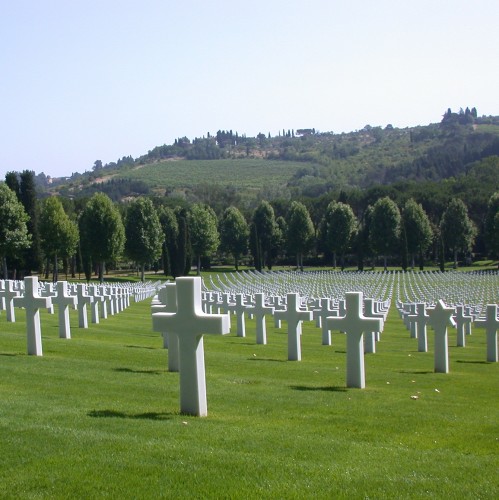
Don’t merely stop at the base of the hillside monument in the fragrant rose gardens. Climb or drive to the very summit to the high stele (pillar) topped by the carving of a woman clutching olive branches while flying on the back of an eagle – a symbol of peace that seems ready to soar over the gravesites. There is a Memorial Center with a multi-denominational chapel with a star-filled ceiling to one side and a map created in stone (pietra dura), showing the progress of the allied troops on the other. In between is the wall of the Missing – those brave pilots and seamen whose final resting place was never found.
A Short History of the Allied Italian Campaign
Following the capture of Rome on 4 June 1944, the Allies pursued the enemy northward toward the Po River and the Alps. On July 23, they entered Pisa. Florence fell to the U.S. Fifth Army on 4 August 1944. But some of the worst fighting was left to come. The Gothic Line, north of Florence, was the final German defensive effort in Italy.
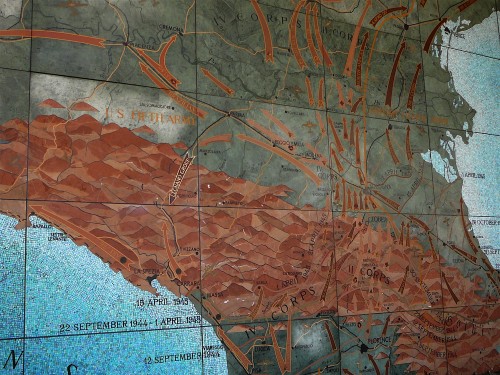
In October 1944, a final bid to capture Bologna brought the U.S. Fifth Army to within nine miles of that city. Forced by harsh weather conditions and shortages of personnel and supplies, the advance stalled for the winter, but fighting continued on in the mountains north of Lucca. The segregated African-American troops, known as the Buffalo soldiers, fought valiantly over Christmas 1944 to protect the small hill towns of Sommocolonia and Barga. A fictionalized version of these battles was the subject of the James McBride book and a Spike Lee movie in 2008.
Preceded by massive air and artillery bombardment, the offensive proceeded northward on 9 April 1945. Although the offensive met stiff opposition, Bologna fell to the U.S. Fifth Army on 21 April 1945. With the establishment of a bridgehead across the PoRiver on 23 April 1945, the fleeing forces were pursued rapidly northward. The final week of the war saw wide advances throughout northern Italy. On 2 May 1945, the enemy troops in northern Italy surrendered.
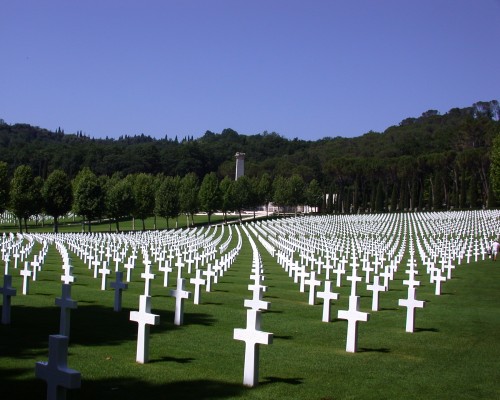
The Florence American Cemetery and Memorial
The Florence American Cemetery is one of fourteen permanent American World War II military cemetery memorials erected on foreign soil by the American Battle Monuments Commission.
The countryside and small towns around the cemetery were liberated on 3 August 1944 by the South African Sixth Armored Division, and later became part of the zone of the U.S. Fifth Army. The seven-acre site, a gift of the city of Florence, is located astride the Greve River, and is framed by wooded hills.
4,402 servicemen and women are interred in the cemetery. Most died in the fighting which occurred after the capture of Rome in June 1944. Included among them are casualties of the heavy fighting in the Apennines, shortly before the war’s end.
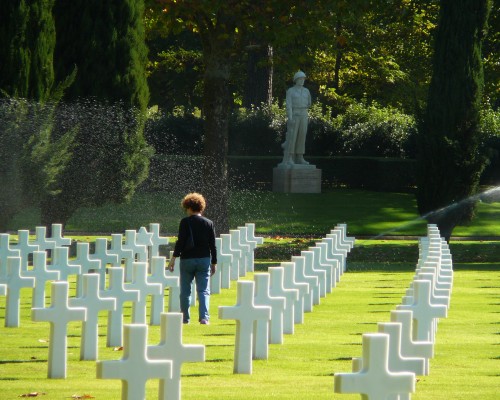
In the memorial are many maps of the progress of German occupation of Europe, as well as two maps of the Italian Allied Campaign. The larger of the maps depicts Northern Italy and portrays military operations to the end of the war from the vicinity of the cemetery northward. The military operations as well as the general topography of the area are depicted in a mosaic of colored marbles, known as intarsia, an art form for which Florence is famous. The map is embellished in its upper left-hand corner by twelve shields, each bearing the shoulder insignia of American ground and air units that participated in the fighting in Northern Italy.
The smaller map illustrates the broad outline of military operations that took place in Sicily and then, throughout Italy, beginning in July 1943. The map was executed in scagliola by Emilio Martelli of Florence, a process consisting of drawings in colored artificial compositions that are inlaid in marble and glazed.
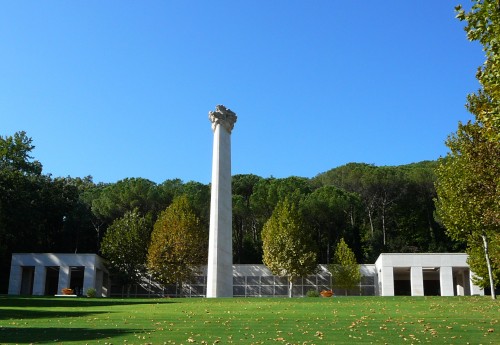
The Tablets of the Missing, which connect the north and south atria of the memorial, inscribed with the names and particulars of 1,409 Missing in Action in the region or lost or buried at sea, are constructed of travertine stone. Running the full length of the Tablets of the Missing above the names is the following inscription: HERE ARE RECORDED THE NAMES OF AMERICANS WHO GAVE THEIR LIVES IN THE SERVICE OF THEIR COUNTRY AND WHO SLEEP IN UNKNOWN GRAVES.
Within the graves area, the pure white marble (quarried north of Lake Como) headstones radiate in soft arcs, curving inward, following the shape of the gently sloping hills. Two rows of tall plane trees border a walkway that divides the cemetery.
The 69-foot pillar at the top of the walkway is inscribed in English and Italian:
1941-1945
IN PROUD MEMORY OF HER SONS AND
IN HUMBLE TRIBUTE TO THEIR SACRIFICES
THIS MEMORIAL HAS BEEN ERECTED BY
THE UNITED STATES OF AMERICA
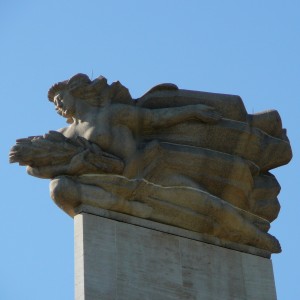
The Florence American Cemetery and Memorial is situated approximately 7.5 miles (12 kilometers) south of Florence, Italy, on the west side of the Via Cassia, the main highway between Florence and Siena. The SITA bus from Florence to San Casciano stops at Falciani for visitors to the cemetery.
The Cemetery and Memorial are open daily to the public from 9:00 am to 5:00 pm except December 25 and January 1. A staff member is on duty in the Visitors’ Building to answer questions and escort relatives and groups to grave and memorial sites.
